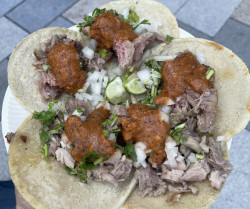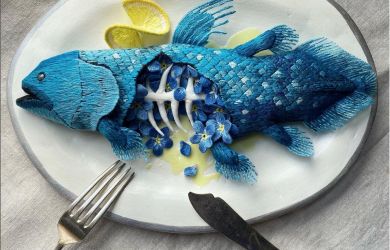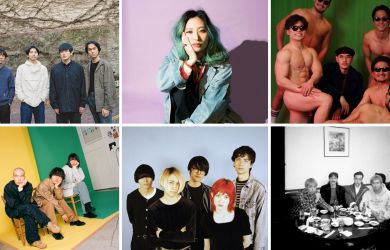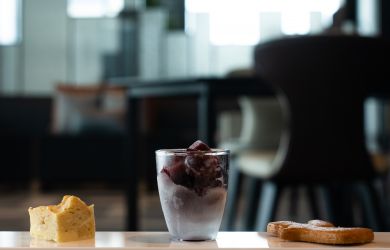
November 26, 2009
Koenji Yakitori
Explore a world of cheap drinks, street eating and wobbly tables
By Metropolis
Originally published on metropolis.co.jp on November 2009
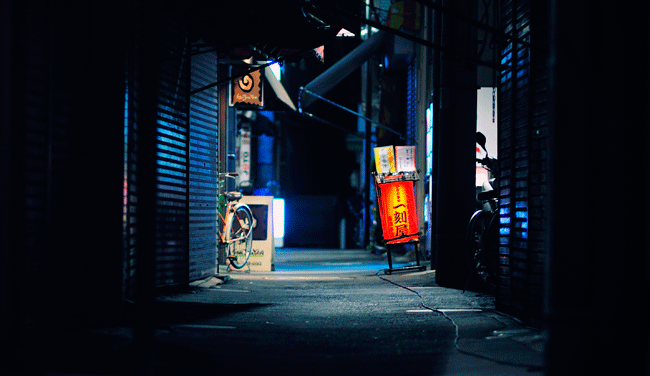
Photo by Hunter Skipworth (Japanorama)
The past few years have seen a host of yakitori shops and drinking dens sprout like weeds along the Chuo line near Koenji station. All are within an easy stagger of the next, as we discovered on a recent visit.

Photo by Hunter Skipworth (Japanorama)
Our first stop is Miyagawa, a small neighborhood yakitori joint. There’s no question that we’ll be sitting outside at the wobbly little tables, as the shop consists of a short, narrow bar and not much else. At 6pm, it’s already full to capacity; the customers look like they arrived when the place opened and will still be there when it closes.
With Falstaffian flair, an old regular orders three large bottles of Sapporo (¥450 each) for his first round. A man on a bicycle stops near us and shouts toward the bar; someone inside answers with another shout. A few more yells and the man nods and continues on his way. This is how one inquires about a friend’s health in Koenji.
We try the piman-tsukune (¥250), a green pepper halved and stuffed with diced chicken. It’s a nice start to the evening, but the wind has picked up, and the temperature of the food quickly matches that of the outside air. Alfresco dining isn’t going to work tonight, so we retreat around the corner to the sheltered arcade under the Chuo.

Photo by Hunter Skipworth (Japanorama)
We stop at Shimonya, which is even smaller than Miyagawa. Ten customers are already crowded into the shop, so we take seats in the overflow area: low stools at beer-crate tables on the walkway outside.
We begin with an oolong hai (¥350) and jidori tataki (¥250), which is excellent. Most of the yakitori menu is priced at ¥100 a stick, and we order tsukune, ibukuro (pork stomach) and nankotsu, along with a warming cup of motsu soup (¥350). The most expensive item seems to be the rather modest draft beers (¥500), which arrive in heavily iced mugs—something that would have been more welcome on a warmer day.
We decide to try a larger establishment next and head to Taisho #3 on the north side of the station. Taisho is something of a Koenji institution, famed for the excellent tare (sauce) on the yakitori.
With seating for 70, the #3 shop is a boisterous beer hall compared to our previous stops. As we wait to get a seat inside, we receive our first disappointment of the evening: draft beer (¥400) in a plastic cup—the lowest form of conviviality. Somewhat skeptical, we move inside, which is smoky from cigarettes as much as charcoal, but the beer does at least come in glasses here.

Photo by Hunter Skipworth (Japanorama)
Our friends enjoy the yakitori moriawase (¥500) while we order an oolong hai (¥350) and sample the sticks. The food is clearly a step up. We aren’t usually fans of soft kawa (¥100), but the tare makes it appealing and we end up having another. The tsukune (¥120) is also a significant improvement on what we had earlier.
Although we prefer the sepia-toned atmosphere under the Chuo, Taisho #3 is festive and bright, making it easy to stay longer than planned—and we do, well past the fourth oolong hai. Finally, five hours after beginning our tour, we head for the train. So many sticks, so little time.
Miyagawa: 3-58-15 Koenji-Minami, Suginami-ku.
Tel: 03-3316-2230
Open daily 5pm-3am
Shimonya: 3-69-1 Koenji-Minami, Suginami-ku.
Tel: 03-3330-7273
Open daily 4-11pm
Taisho #3: 2-9-6 Koenji-Kita, Suginami-ku.
Tel: 03-3338-0323
Open Mon-Fri 5pm-6am, Sat 4pm-6am, Sun 4pm-1am
